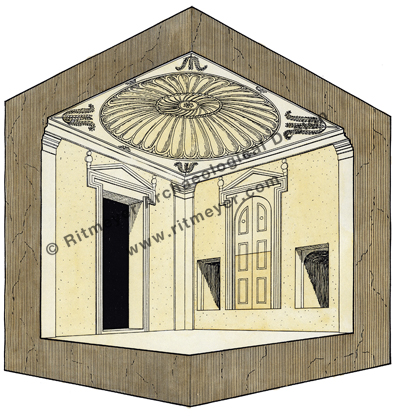In a previous post, we commented on the finding of a 1st century tomb, containing bones and the remains of a linen shroud, next to the Tomb of Annas which we have been able to identify earlier. The tomb was named “The Tomb of the Shroud”. Akeldama is located at the mouth of the Hinnom Valley:


An interesting scientific article has been published with the results of the Molecular Exploration of this tomb:
The Tomb of the Shroud is a first-century C.E. tomb discovered in Akeldama, Jerusalem, Israel that had been illegally entered and looted. The investigation of this tomb by an interdisciplinary team of researchers began in 2000. More than twenty stone ossuaries for collecting human bones were found, along with textiles from a burial shroud, hair and skeletal remains. The research presented here focuses on genetic analysis of the bioarchaeological remains from the tomb using mitochondrial DNA to examine familial relationships of the individuals within the tomb and molecular screening for the presence of disease.
The Tomb of the Shroud is one of very few examples of a preserved shrouded human burial and the only example of a plaster sealed loculus with remains genetically confirmed to have belonged to a shrouded male individual that suffered from tuberculosis and leprosy dating to the first-century C.E. This is the earliest case of leprosy with a confirmed date in which M. leprae DNA was detected.
Historically disfiguring diseases, particularly leprosy and tuberculosis, were commonly categorized together in the Near East and the afflicted individuals were ostracized from their communities. The general Jewish practice in the first century C.E. was for a primary burial to be placed within a loculus until the decomposition of organic remains had taken place, at which point – approximately a year later – the bones were then taken out of the loculus and transferred into a repository (a pit or wall niche) or into a stone ossuary. However this transfer did not occur for the individual buried in Tomb of the Shroud loculus 1 – instead this loculus was sealed with white plaster, a practice which is quite rare in the first century tombs studied around Jerusalem.
In the conclusion the authors note that the disease of leprosy did not distinguish between rich and poor. The prevalence of such a highly contagious disease, particularly for immuno-compromised individuals with leprosy is not unexpected with inadequate sanitation and demonstrates the significant impact social diseases such as tuberculosis had on society from the low socioeconomic groups up to the more affluent families, such as Tomb the Shroud in first-century Jerusalem.
It is interesting to read in the New Testament of a Simon the Leper, who lived in Bethany (Matt. 26.6). He may have been the leper that was healed by Jesus in Matt. 8.2. Leprosy is an ancient disease, as we are told in Luke 4.27: “there were many lepers in Israel in the time of the prophet Elisha”, but only Naaman the Syrian was healed.
The above article states that leprosy is a highly contagious disease. This was known already in the time of Moses (Lev. 13,14), where stringent laws were put ion place to contain leprosy by isolating the people who suffered from it. This was reiterated again in Deuteronomy 24.8: “Take care, in a case of leprosy, to be very careful to do according to all that the Levitical priests shall direct you.”
Unfortunately, it did not save this particular individual whose remains were sealed and found some 2,000 years later.

Just to mention that the Hansen “Leper” hospital built by Conrad Schick in 1887 has an interesting historical and art exhibit “Behind the Walls” in the old hospital.
Plans are underway to turn the hospital into a municipal cultural center, a meeting place for the arts, media and technology.
Fascinating exhibit on the Shroud of Turin at Notre Dame across from New Gate. Also an incredible view of the Old City from their wine and cheese bar on the roof.